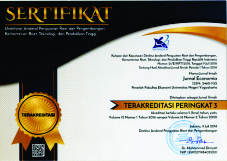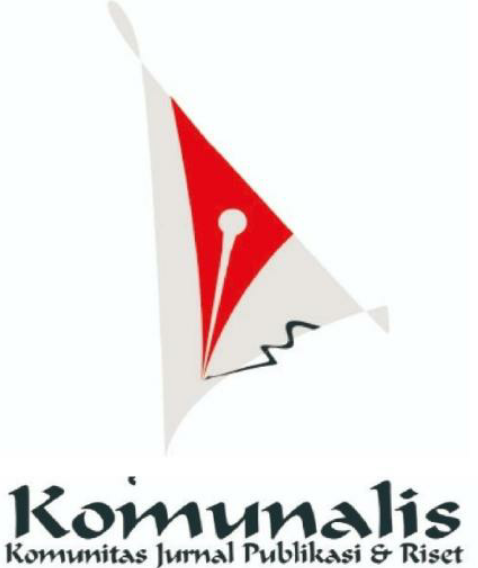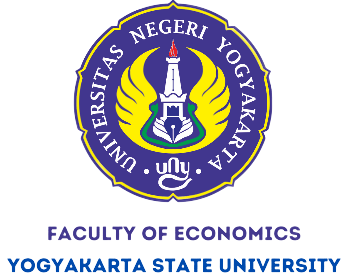Company Characteristics as Antecedent of Mandatory Disclosure of Acounting Information
Downloads
Abstract: Company Characteristics as Antecedent of Mandatory Disclosure of Acounting Information. The objective of this research was to get knowledge about the influence of company characteristics including company size, company age, profitability, leverage, and company growth toward mandatory disclosure. The research was research of causality. The sample used in this research was 47 manufacturing companies from 129 manufacturing companies listed in the Indonesia Stock Exchange in 2012. Purposive sampling was the technique used to select samples. Data was analyzed by using multiple linear regressions. Before multiple linear regressions were conducted, the normality, heteroscedasticity, linearity, and multicolinearity must be met. The results showed that company size, company age, profitability, leverage, and company growth had no effect to mandatory disclosure.
Keywords: mandatory disclosure, company size, company age, profitability, leverage, company growth
Abstrak: Karakteristik Perusahaan Sebagai Anteseden Pengungkapan Wajib Informasi Akuntansi. Penelitian ini bertujuan untuk mengetahui pengaruh karakteristik perusahaan yang meliputi ukuran perusahaan, umur perusahaan, profitabilitas, leverage, dan pertumbuhan perusahaan terhadap pengungkapan wajib. Penelitian ini merupakan penelitian kausalitas. Sampel yang digunakan yaitu 47 perusahaan manufaktur dari 129 perusahaan manufaktur yang terdaftar di Bursa Efek Indonesia tahun 2012. Pemilihan sampel dilakukan dengan teknik purposive sampling. Data dianalisis dengan regresi linear berganda. Uji prasyarat analisis meliputi uji normalitas, heteroskedastisitas, linearitas, dan multikolinearitas dilakukan terlebih dahulu. Hasil penelitian menunjukkan bahwa ukuran perusahaan, umur perusahaan, profitabilitas, leverage, dan pertumbuhan perusahaan tidak berpengaruh terhadap pengungkapan wajib.
Kata Kunci: pengungkapan wajib, ukuran perusahaan, umur perusahaan, profitabilitas, leverage, pertumbuhan perusahaan
Downloads
Adina, P. & Ion, P. (2008). "Aspect Regarding Corporate Mandatory and Voluntary Disclosure" Annals of the University of Oradea: Economic Science, 3 (1), 1407-1411.
Ahmed, K. & Courtis, J.K. (1999). "Associations between Corporate Characteristics and Disclosure Levels in Annual Reports: A Meta-Analysis" British Accounting Review, 31 (1), 35-61.
Ahmed, K. & Nicholls, D. (1994). "The Impact of Non-Financial Characteristics on Mandatory Disclosure Compliance in Developing Countries: The Case of Bangladesh" International Journal of Accounting, 19 (3), 62-77.
Akhtaruddin, M. (2005). "Corporate Mandatory Disclosure Practices in Bangladesh" The International Journal of Accounting, 40, 399-422.
Alanezi, F.S. & Albuloushi, S.S. (2010). "Does the Existence of Voluntary Audit Committees Really Affect IFRS-Required Disclosure? The Kuwait Evidence" International Journal of Disclosure and Governance, 8 (2), 148-173.
Ali, M., dkk. (2004). "Disclosure Compliance with National Accounting Standard by Listed Companies in South Asia" Accounting and Business Research, 34 (3), 183-199.
Aljafiri, K. (2008). "Annual Report Disclosure in a Developing Country: The Case of the UAE" Advances in Accounting, Incorporating Advances in International Accounting, 24, 93-100.
Al-Mutawaa, A. & Hewaidy, A.M. (2010). "Disclosure Level and Compliance with IFRS: An Empirical Investigation of Kuwaiti companies" The International Business and Economics Research Journal, 9 (5).
Arcay, M.R.B. & Vazquez, M.F.M. (2005). "Corporate Characteristics, Governance Rules and the Extent of Voluntary Disclosure in Spain" Advances in Accounting, 21, 299-331.
Arifin, J. (2004). Analisis Laporan Keuangan Berbasis Komputer. Jakarta: Elex Media Komputindo.
Ball, R. & Foster, G. (1982). "Corporate Financial Reporting: A Methodological Review of Empirical Research" Journal of Accounting Research, 20 (Suppl), 161-234.
Barako, D., dkk. (2006). "Factors Influencing Voluntary Corporate Disclosure by Kenyan Companies" Corporate Governance: An International Review, 14 (2), 107-125.
Benjamin, T.Y., dkk. (1990). "Non Compliance with Disclosure Requirements in Financial Statement: The Case of Hongkong Companies" The International Journal of Accounting, 25, 99-112.
Bova, F. & Pereira, R. (2012). "The Determinants and Consequences of Heterogeneous IFRS Compliance Levels Following Mandatory IFRS Adoption: Evidence from a Developing Country" Journal of International Accounting Research, 11 (1), 83-111.
Cahyati, A.D. (2011). "Peluang Manajemen Laba Pasca Konvergensi IFRS: Sebuah Tinjauan Teoritis dan Empiris" Jurnal Riset Akuntansi dan Komputerisasi Akuntansi, 2 (1), 1-7.
Chau, G.K. & Gray, S.J. (2010). "Family Ownership, Board Independence, and Voluntary Disclosure: Evidence from Hong Kong" Journal of International Accounting, Auditing, and Taxation, 19, 93-109.
Choi, F. (2005). International Accounting. New Jersey: Prentice Hall.
Cooke, T.E. (1989). "Disclosure in the Corporate Annual Report of Swedish Companies" Accounting and Business Research, 19 (74), 113-124.
Darrough, M.N. (1993). "Disclosure Policy and Competition: Cournot vs Bertrand". The Accounting Review, 68 (3), 534-561.
Depoers, F. (2000). "A Cost-Benefit Study of Voluntary Disclosure: Some Empirical Evidence from French Listed Companies" The European Accounting Review, 9 (2), 245-263.
Easley, D. & O'hara, M. (2004). "Information and the Cost of Capital" Journal of Finance, 59, 1553-1583.
Ghozali, I. (2011). Aplikasi Analisis Multivariate dengan Program IBM SPSS 19. Semarang: Badan Penerbit Universitas Diponegoro.
Glaum, M. & Street, D.L. (2003). "Compliance with the Disclosure Requirements of Germany's New Market: IAS versus US GAAP" Journal of International Financial Management and Accounting" 14(1): 64-100.
Haniffa, R. & Cooke, T. (2002). "Culture, Corporate Governance and Disclosure in Malaysian Corporations" Abacus, 38 (3), 317-349.
Healy, P.M. & Palepu, K.G. (2001). "Information Asymmetry, Corporate Disclosure, and the Capital Market: A Review of the Empirical Disclosure Literature" Journal of Accounting and Economics, 31, 405-440.
Healy, P.M., dkk. (2001). "Stock Performance and Intermediation Change Surrounding Sustained Increases in Disclosure" Contemporary Accounting Research, Fall, 485-520.
Inchausti, B.G. (1997). "The Influence of Company Characteristics and Accounting Regulations on Information Disclosed by Spanish Firms" The European Accounting Review, 1 (1), 45-68.
Jensen, M. & Meckling, W. (1976). "Theory of the Firm: Managerial Behavior, Agency Costs, and Ownership Structure" Journal of Financial Economics, 3 (3), 305-360.
Karim, A.K.M.W. & Ahmed, J.U. (2005). "Determinants of IAS Disclosure Compliance in Emerging Economics: Evidence from Exchange-Listed Companies in Bangladesh". Working Paper, Wellington: Victoria University of Wellington.
Latridis, G. (2008). "Accounting Disclosure and Firms' Financial Attributes: Evidence from the UK Stock Market" International Review of Analysis, 17, 219-241.
Malone, D., dkk. (1993). "An Empirical Investigation of the Extent of Corporate Financial Disclosure in the Oil and Gas Industry" Journal of Accounting, Auditing, and Finance, 8 (3), 249-273.
Marston, C.L. & Shrives, P.J. (1991). "The Use of Disclosure Indices in Accounting Research: A Review Article" British Accounting Review, 23 (23), 195-210.
McKinnon, J.L. & Dalimunthe, L. (1993). "Voluntary Disclosure of Segmen Information by Australian Diversified Companies" Accounting and Finance, 33 (1), 33-50.
Meek, G.K., dkk. (1995). "Factors Influencing Voluntary Annual Report Disclosures by US, UK, and Continental European Multinational Corporation" Journal of International Business Studies, 26 (3), 555-572.
Mintara, Y.H. (2008). "Pengaruh Implementasi Corporate Governance terhadap Pengungkapan Informasi". Skripsi, Yogyakarta: Universitas Islam Indonesia.
Naser, K. (1998). "Comprehensiveness of Disclosure of Non-Financial Companies Listed on the Amman Financial Market" International Journal of Commerce and Management, 8 (1), 88-119.
Omar, B. & Simon, J. (2011). "Corporate Aggregate Disclosure Practice in Jordan." Advances in Accounting, incorporating Advances in International Accounting, 27, 166-186.
Owusu-Ansah, S. (1998). "The Impact of Corporate Attributes on the Extent of Mandatory Disclosure and Reporting by Listing Companies in Zimbabwe" International Journal of Accounting, 33 (5), 605-631.
Owusu-Ansah, S. & Yeoh, J. (2005). "The Effect of Legislation on Corporate Disclosure Practices" Abacus, 41 (1), 92-109.
Popova, T. (2013). "Mandatory Disclosure and Its Impact on the Company Value" International Business Research, 6 (5), 1-16.
Prawinandi, W., dkk. (2012). Peran Struktur Corporate Governance dalam Tingkat Kepatuhan Mandatory Disclosure Konvergensi IFRS. Diakses dari http://asp.trunojoyo.ac.id/wp-content/uploads/2014/03/067-CG-21.pdf pada tanggal 25 April 2016.
Rusiti, Ch., & Kurniawan, Y.A. (2013). "Faktor-faktor yang Mempengaruhi Luas Pengungkapan Sukarela pada Laporan Tahunan Perusahaan di Bursa Efek Indonesia". Simposium Nasional Akuntansi XVI. Manado: Universitas Sam Ratulangi.
Suhardjanto, D. & Wardhani, M. (2010). "Praktik Intellectual Capital Disclosure Perusahaan yang Terdaftar di Bursa Efek Indonesia" Jurnal Akuntansi dan Auditing Indonesia, 14 (1), 71-85
Silviana, Y.H.K. (2014). "Perbedaan Tingkat Pengungkapan antara Perusahaan Asing dan Domestik dengan Adanya Konvergensi IFFRS". Skripsi. Yogyakarta: Universitas Atmadjaya.
Setianto, A. (2014). "Penerapan IFRS dan Hubungannya dengan Komparabilitas Pengungkapan Aset Tetap pada Laporan Keuangan Perusahaan". Skripsi. Semarang: Universitas Diponegoro.
Utami, W.D., dkk. (2012). Investigasi dalam Konvergensi IFRS di Indonesia: Tingkat Kepatuhan Pengungkapan Wajib dan Kaitannya dengan Mekanisme Corporate Governance. Diakses dari http://asp.trunojoyo.ac.id/wp-content/uploads/2014/03/066-CG-20.pdf pada tanggal 25 April 2016.
Wallace, R.S.O. (1987). "Disclosure of Accounting Information in Developing Countries: A Case Study of Nigeria". Unpublished Ph.D Thesis. UK: University of Exter.
Wallace, R.S.O. (1988). "Corporate Financial Reporting in Nigeria" Accounting and Business Research, 18 (72), 352-362.
Wallace, R.S.O. & Naser, K. (1995). "Firm-Spesific Determinants of Comprehensiveness of Mandatory Disclosure in the Corporate Annual Reports of Firms on the Stock Exchange of Hongkong" Journal of Accounting and Public Policy, 14, 311-368.
Wallace, R.S.O., dkk. (1994). "The Relationship between the Comprehensiveness of Corporate Annual Reports and Firm Characteristics in Spain" Accounting and Business Research, 25 (97), 41-53.
Yulianti, I. & Probohudono, A.N. (2013). "Studi Komparasi praktik IFRS Disclosure Compliance di Indonesia, Malaysia, Singapura, dan Australia" Simposium Nasional Akuntansi XVI. Manado: Universitas Sam Ratulangi.















